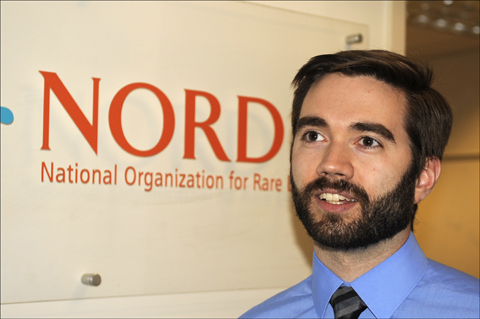The Challenging Job of Representing the Rare Disease Community in Washington

With nearly 7,000 rare diseases, including Duchenne muscular dystrophy, affecting an estimated 30 million Americans, it’s hard for Paul Melmeyer to keep track of them all.
As director of federal policy at the National Organization for Rare Disorders (NORD), Melmeyer’s job is to represent the rare disease patient in Washington, engaging with lawmakers and regulatory agencies at both the federal and state level. He also meets regularly with officials of the U.S. Food and Drug Administration, the National Institutes of Health and the Social Security Administration, whose financial safety net extends to disabled Americans.
NORD was founded in 1983 as an association of patient organizations and advocates that successfully lobbied for passage of the Orphan Drug Act.
“Ever since then, our role has been to support the rare disease patient organizations and act as a union of those associations,” Melmeyer said in an interview with Muscular Dystrophy News.
NORD operates from the fifth floor of a Dupont Circle office building that also houses the Pulitzer Center, the Carnegie Endowment for International Peace and the Embassy of Papua New Guinea. Its 260 or so member organizations include Parent Project Muscular Dystrophy (PPMD), Cure Duchenne, the Jett Foundation and other nonprofit groups dedicated to finding a cure for rare diseases. The government defines a rare disease as one that affects 200,000 or fewer Americans.
Some of NORD’s members, like the Cystic Fibrosis Foundation, are large and influential. Others are tiny and cater to extremely rare disorders that affect only a few hundred people.
For example, NORD speaks for PRISMS, which deals with Smith-Magenis syndrome, and the Fibrous Dysplasia Foundation, which has only two staffers.
“We did a survey showing that 70 percent of our member organizations have fewer than five full-time employees,” Melmeyer said. “Many of them may have only one or two staffers or volunteers. That’s indicative of the level of resources that only a handful of people are paying attention to them.”
On the wall of Melmeyer’s office are posters that constitute The Orphan Drug Hall of Fame. They include Norditropin, an injectable growth hormone approved by the FDA in August 2006; Revlimid, a multiple myeloma therapy approved in December 2005; and Cystadane, an oral powder to treat homocystinuria that was approved in May 1994.
Some therapies are way beyond the budgets of most of the families who have children with Duchenne MD. In fact, they are unattainable without insurance coverage or other assistance.
They include Exondys 51 (eteplirsen), Sarepta Therapeutics’ injectable drug for patients with a Duchenne MD gene mutation. Another is PTC Therapeutics’ corticosteroid Emflaza (deflazacort), which works by decreasing inflammation and reducing immune system over-activity.
“We’ve been hearing from a lot of patients who are frustrated by the cost of these therapies, and also a lot from advocates who want us to focus more on ensuring innovation and less on what the end-stage cost is,” Melmeyer said.
“We see both sides of those arguments,” he said, adding that “we have been very public in our advocacy over the last couple of months, ever since efforts to repeal and replace the Affordable Care Act started last year. We understood it was going to take a very large effort on our part to protect our patients.”
Tiny organizations pay $50 a year to belong to NORD, while larger ones pay a few hundred dollars. NORD sometimes offers research grants, partnering with a specific disease community.
“We are seeing patient organizations starting to get more and more into investing in companies, or in researchers who the patient organization will have partial stock in whatever compound is being developed, and then is able to engage within the sale of that compound — or maybe infuse investments into the company,” Melmeyer said.
For example, the Cystic Fibrosis Foundation invested from start to finish in Vertex’s effort to develop Kalydeco and Orkambi.
“It takes upwards of seven to 10 years for a rare disease patient to be diagnosed,” Melmeyer said. “And because there are so few doctors who are well-versed, it can take many physician visits and traveling around to obtain that diagnosis. We know patients who are still undiagnosed and they are adults.”
Eighty percent of rare diseases are genetic, he said, and half of the patients who have them are children. Some, like Huntington’s, only manifest themselves in adulthood.
NORD’s donors are mainly individuals and foundations, although some money comes from pharmaceutical companies. The organization also has a grant from the FDA to work on patient history registries.
“Last year, over 40 percent of the therapies the FDA approved were orphan drugs. We’re very happy that is the case,” Melmeyer said. “It’s been growing each year. Back in the ‘80s, we’d see one, two, maybe three approved each year. In the ‘90s, that increased very slightly, but it didn’t get to over 10 a year. Really, it’s only within the last 10 years or so that we’ve seen a substantial increase in the development and approval of rare drugs for diseases.”
NORD does not take positions on drug pricing, including what an appropriate price for a therapy should be, he said.
“When we look at the drug pricing debate, we are constantly weighing the two sides,” he said. “On one side, we need to encourage innovations for individuals with rare diseases, while, on the other, ensuring these same therapies are accessible. It’s such a delicate balancing act.”
He added: “We support PPMD, the Jett Foundation and Cure Duchenne, but we as an organization can’t dive into that policy debate ourselves. We have drawn a line in the sand for ourselves to not get involved. Once we do, in the interest of consistency we’d have to do that for any drug. Knowing we can’t get involved with all of the 20 to 25 orphan drugs the FDA approves in any given year, we decline to do disease-specific or drug-specific policy.”
The FDA approved Exondys 51 last September. The drug costs $325,000 a year, but “that’s not what insurers actually pay,” said Melmeyer.
“There are rebate laws and negotiations, so insurers often pay substantially less than list price,” he told Muscular Dystrophy News. “This is a perfect example of why drug pricing is an important issue to discuss, but these things are incredibly complicated and should not be addressed through oversimplified attempts at policymaking.”
Melmeyer, a native of Pittsburgh, interned for Sen. Bob Casey, a Democrat from Pennsylvania, before working on health policy issues at the Center for American Progress and joining NORD in February 2013 as associate director of public policy. He’s been in his current position for five months.
“What we would like to see is a more deliberative, comprehensive and informed conversation on the benefits and costs of the current pricing system in the United States — one that does not come with a pre-conceived goal in mind, and one in which the stakeholders are at the table, motivated by patient access,” he said.
“We do believe that the pharmaceutical companies want to ensure that patients with the disease can access their therapy,” he added. “There are publicity benefits for doing so — especially for kids with a very serious disease. It looks good. But we want it because our patients don’t have any other options. Many of these orphan drugs will substantially improve the quality of their lives, which is why we hope the insurance companies will see the value of these therapies.”







